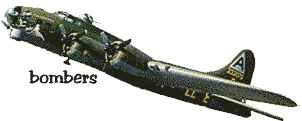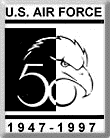NORTH AMERICAN P-51D "MUSTANG" 
The P-51 was designed as the NA-73 in 1940 at Britain's request. The design showed
promise and AAF purchases of Allison-powered Mustangs began in 1941 primarily for photo
recon and ground support use due to its limited high-altitude performance. But in 1942,
tests of P-51s using the British Rolls-Royce "Merlin" engine revealed much
improved speed and service ceiling, and in Dec. 1943, Merlin-powered P-51Bs first entered
combat over Europe. Providing high-altitude escort to B-17s and B-24s, they scored heavily
over German interceptors and by war's end, P-51s had destroyed 4,950 enemy aircraft in the
air, more than any other fighter in Europe.
Mustangs served in nearly every combat zone, including the Pacific where they escorted
B-29s to Japan from Iwo Jima. Between 1941-5, the AAF ordered 14,855 Mustangs (including
A-36A dive bomber and F-6 photo recon versions), of which 7,956 were P-51Ds. During the
Korean Conflict, P-51Ds were used primarily for close support of ground forces until
withdrawn from combat in 1953.
The P-51D on display was obtained from the West Virginia ANG in 1957 and was the last
prop-driven USAF fighter assigned to a tactical unit. It is painted as the -D flown by
Col. C.L. Sluder, CO of the 325th Fighter Group, 15th Air Force, in Italy in 1944. The
name of this aircraft, Shimmy IV is derived from the names of Col. Sluder's
daughter and wife; Sharon and Zimmy.
SPECIFICATIONS
Span: 37 ft. 0 in.
Length: 32 ft. 3 in.
Height: 13 ft. 8 in.
Weight: 12,100 lbs. max.
Armament: Six .50-cal. machine guns and ten 5 in. rockets or 2,000 lbs. of bombs.
Engine: Packard built Rolls-Royce "Merlin" V-1650 of 1,695 hp.
Cost: $54,000
Serial Number: 44-74936
Displayed as (S/N): 44-15174
PERFORMANCE
Maximum speed: 437 mph.
Cruising speed: 275 mph.
Range: 1,000 miles
Service Ceiling: 41,900 ft.
  

*Not every plane flown by the WASP is represented in this list. We
are still gathering pictures and information. We will add to this as we discover new
sources for pictures.
Special thanks to the AIR FORCE MUSEUM for allowing us to share some of
their pages! You can find more USAF history, planes and information by visiting
their site:

home | arcade | gallery | video | records | resources | interact| shop | wings across america
|